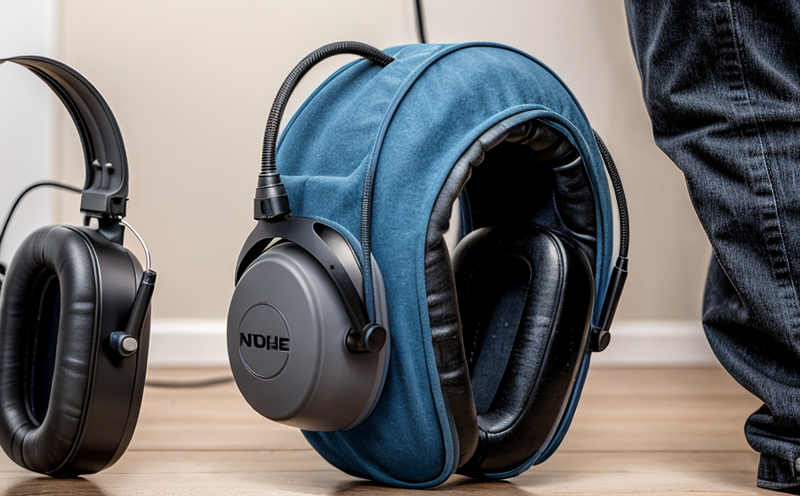ISO 4869-12 Hearing Protector Temperature Resistance Testing
The ISO 4869-12 standard specifies the methods for determining the temperature resistance of hearing protectors. This testing is crucial in industries where workers are exposed to extreme temperatures, such as foundries, construction sites, and mining operations. The primary goal of this test is to ensure that the hearing protection devices maintain their integrity and effectiveness under varying thermal conditions.
The testing process involves subjecting the hearing protector to a specified temperature for a defined duration. According to ISO 4869-12, the device must not exhibit any signs of damage or degradation in its performance metrics after exposure. This includes checking for changes in attenuation levels and comfort fit over time.
The procedure begins with selecting an appropriate hearing protector based on the expected environmental conditions. Once selected, the device is placed inside a thermal chamber where it undergoes controlled temperature cycling from -20°C to 50°C. The duration of exposure can vary depending on the specific requirements of the industry but typically ranges between 1 hour and 8 hours.
Following the test, detailed measurements are taken using specialized equipment such as sound level meters and fit testers. These tools help assess whether there has been any alteration in the noise reduction rating (NRR) or other critical performance indicators. If significant changes are detected, further analysis may be required to determine if these deviations impact overall worker safety.
The results from this testing play a vital role in certifying that hearing protectors meet international standards for occupational health and safety. By ensuring compliance with ISO 4869-12, manufacturers can provide workers with reliable protection against both excessive noise levels and extreme temperatures, thereby enhancing workplace safety across various sectors.
For quality managers responsible for maintaining strict adherence to regulatory requirements, this test offers valuable insights into the durability of hearing protectors under real-world conditions. Compliance officers will find it essential in verifying that their organization's products meet stringent industry standards. R&D engineers can use these findings to refine designs and improve product performance continuously.
Finally, procurement professionals benefit from knowing which suppliers offer compliant solutions, helping them make informed decisions when selecting suppliers for their organizations.
Scope and Methodology
The scope of ISO 4869-12 hearing protector temperature resistance testing encompasses various types of hearing protectors including earplugs, earmuffs, and combination devices. The methodology involves exposing the selected hearing protector to a range of temperatures within an environmental chamber. This exposure simulates conditions workers might encounter in different environments.
- Temperature range: -20°C to 50°C
- Duration of exposure: Typically between 1 and 8 hours, depending on specific needs
- Measurement tools used: Sound level meters, fit testers
The methodology also includes evaluating the impact of temperature variations on key performance indicators such as noise reduction ratings (NRR), insertion loss values, and comfort factors. Additionally, any changes in physical properties like elasticity or shape memory are assessed to ensure the protector remains functional.
It's important to note that while this standard focuses primarily on mechanical aspects, it also considers ergonomic considerations to maintain user comfort during prolonged use. Compliance with ISO 4869-12 ensures not only effective noise reduction but also comfort and ease of use for end-users.
Customer Impact and Satisfaction
- Enhanced Worker Safety: By ensuring that hearing protectors remain effective under extreme temperature conditions, this test significantly reduces the risk of occupational deafness caused by prolonged exposure to loud noises.
- Increased Product Reliability: Manufacturers who comply with ISO 4869-12 can confidently market their products as reliable and safe for use in challenging environments.
- Better Decision-Making: Quality managers, compliance officers, and R&D engineers gain valuable information that helps them make better-informed decisions about product development and procurement strategies.
Customer satisfaction is paramount in any business relationship. When customers know they are receiving products that meet strict international standards like ISO 4869-12, trust increases among stakeholders. This leads to higher customer loyalty and repeat purchases, ultimately contributing to long-term success for businesses operating within this sector.
Environmental and Sustainability Contributions
The implementation of ISO 4869-12 testing contributes positively towards sustainable practices by promoting the use of high-quality hearing protectors that are durable and effective even in challenging environments. This reduces waste generation associated with frequent replacement due to product failure.
- Reduced Waste: Effective protection ensures longer product lifespan, reducing the need for constant replacement which helps minimize landfill contributions from discarded products.
- Eco-friendly Materials: Many modern hearing protectors incorporate eco-friendly materials that are recyclable or biodegradable. Testing according to ISO 4869-12 ensures these materials maintain their integrity and performance even under harsh conditions, thus extending product life cycles further.
Incorporating sustainable practices into manufacturing processes not only benefits the environment but also aligns companies with broader societal expectations regarding corporate social responsibility (CSR). This can enhance brand reputation and attract environmentally conscious consumers who prioritize sustainability when making purchasing decisions.





